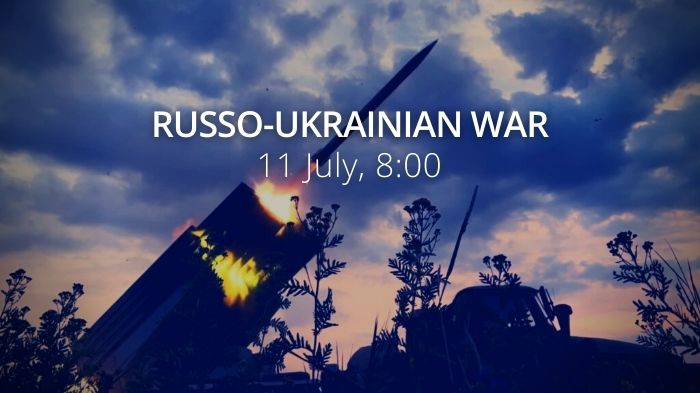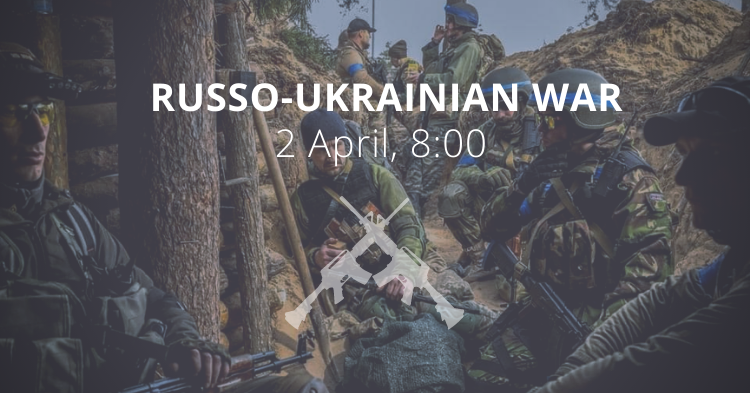Zelenskyy orders to de-occupy the south of Ukraine. Ukrainian authorities call on the residents to evacuate. In the south, the Ukrainian Armed Forces continue to strike Russian ammunition and equipment warehouses and command posts. In a week, Russians lost more than a dozen ammunition depots. The Ukrainian army destroys the headquarters of the Russian Guard in Kherson. Russians continue shelling Kharkiv and hit Chasovoy Yar, a town in the Donetsk Oblast, killing 24.
Daily overview — Summary report, July 11
According to military expert Stanislav Haider, as of July 11,
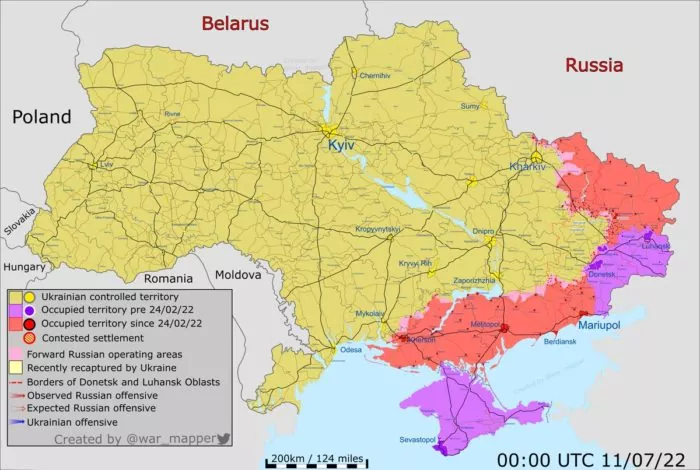
Donetsk oblasts. In the Sloviansk direction, Russian forces stormed again the direction of Bohorodychne-Krasnopillia-Dolyna and managed to advance approximately 1 km in Bohorodychne as the fighting continued with Russians again staging a tank attack. Ukrainian troops repulsed Russian attacks in the direction of Novoluhanske and Avdiivka.
South of Donetsk Oblast. The main current task for the Ukrainian Armed Forces is to hold newly liberated positions and settlements, and they succeed in it so far.
Luhansk oblast. The non-Russian-occupied part of Luhansk Oblast sees battles going on for every forest, intersection, and house and Ukrainian soldiers are holding firm.
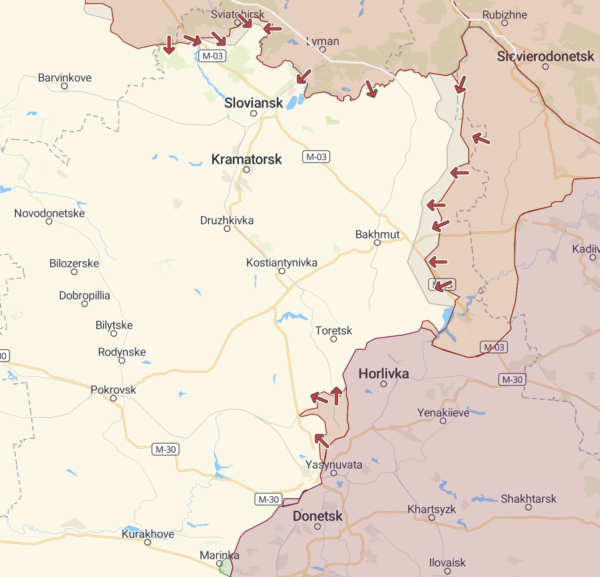
Kharkiv Oblast. Russian troops continue their tactical actions aiming to improve improving the situation with no success. Ukrainian forces press in the area of the Pechenihy reservoir and are also fighting west of Izium, binding Russian forces, which prevents them from launching a full-scale attack on Sloviansk.
Zaporizhzhia Oblast. Tactical battles are ongoing in the direction of Polohy and Vasylivka as Russians have reinforced their forces preparing an offensive in the area, yet the strength and resources of their grouping don't allow them to carry out serious actions.
Kherson Oblast. The advance of the Ukrainian Armed Forces has somewhat slowed down due to the reinforcement of the Russian group of forces in all directions in the region. Russians are trying to counterattack in the area of Inhulets, though unsuccessfully. Fairly intense fighting continues in the direction of Vysokopillia-Arkhanhelske.
The work of Ukrainian artillery. Situated more than 90 kilometers behind the battlefront, Luhansk saw a strike on a warehouse and troops. Ukrainian artillery also worked well near Kherson, destroying a military base and four ammunition warehouses.
The General Staff’s operational update regarding the Russian invasion as of 06.00 am, July 11, 2022 is in the dropdown menu below.
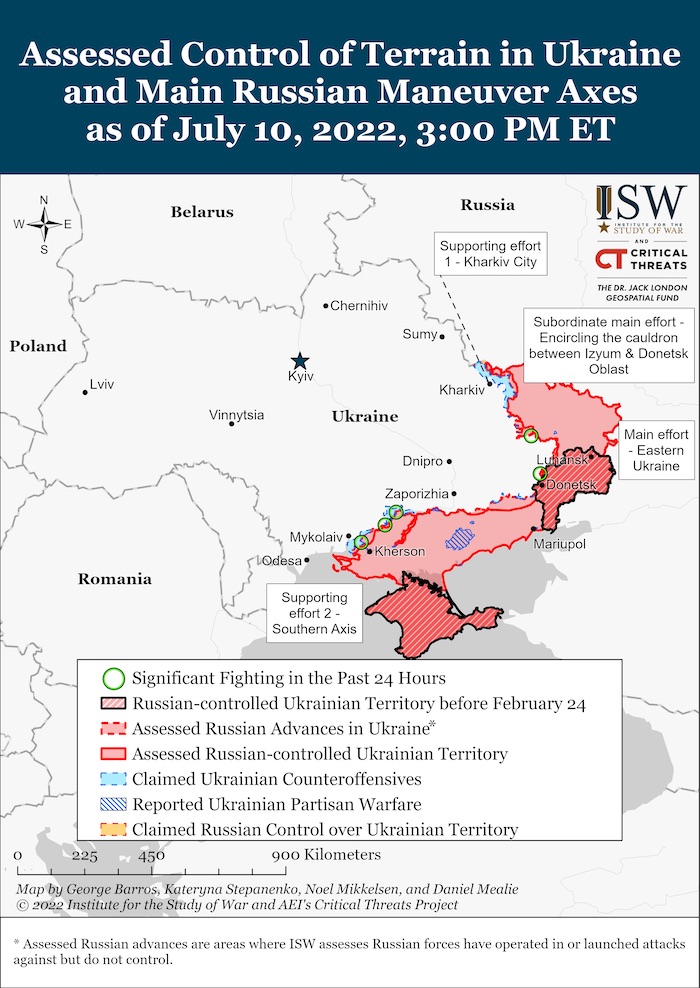
The one-hundred-thirty-eighths (138) day of the heroic resistance of the Ukrainian people to a russian military invasion continues.
There are no significant changes in the quantitative composition and nature of activity of russian enemy in the Volyn, Polissya, and Siversky directions. The enemy shelled the area of Karpovychi settlement of the Chernihiv region with barrel artillery.
In the Slobozhansky direction, enemy units continue to focus their efforts on holding the occupied lines in the Kharkiv direction and preventing the advance of our troops. The enemy is taking measures to provide units with material and technical means.
Fired from artillery, rocket launchers and tanks in the areas of the city of Kharkiv and the settlements of Bazaliivka, Petrivka, Ruski Tyshky, Slatine, Prudyanka, Rubizhne and Blahodatne.
In the Sloviansk direction, the outskirts of Dibrovne, Mazanivka, Bohorodychne, Adamivka, and Kurulka were shelled with barrel and jet artillery. The enemy also carried out an airstrike near Bohorodychne. Ukrainian soldiers successfully repelled the enemy assault in the direction of Krasnopilla.
In the Donetsk direction, there are signs of enemy units preparing to intensify combat operations in the Kramatorsk and Bakhmut directions.
In the Novopavlivsk direction, the enemy is conducting assaults to improve the tactical position. Along the contact line, the occupiers carry out a systematic fire attack on the positions of the units of the Defense Forces in order to constrain their actions. Assault and army aviation became active.
The enemy did not conduct active operations in the Kramatorsk direction.
The areas of the settlements of Siversk, Zakitne, Serebryanka, Hryhorivka, Bilohorivka, Verkhnokamianske and Spirne were shelled with barrel artillery.
In the Bakhmut direction, it fires mortars, barrel and rocket artillery near Berestove, Pokrovske, Soledar, Zaytseve, Vershyna, Novoluhanske, Klishchiivka, and New York.
Delivered missile and air strikes near Berestove, Spirne, Stryapivka, and Vuhlehirska TPP.
On the Avdiivka, Kurakhivka, Novopavlivka, and Zaporizhzhia areas, shelling was recorded in the areas of Avdiivka, Karlivka, Mariinka, Sribne, Novomykhailivka, Vuhledar, Vremivka, Bilohirya, Poltavka, Hulyaipole, Hulyaipilske, Mala Tokmachka, Novodanylivka, Orihiv, and Kamyanske The occupiers launched a missile-air strike near Orikhove and air strikes in the areas of Volodymyrivka, Pavlivka, and Novoandriivka.
Another enemy offensive attempt by the occupiers in the direction of Mariinka completely failed. Under the fire of our soldiers, the invaders shamefully ran back.
In the South Buh direction, the enemy is concentrating its efforts on preventing the advance of units of the Defense Forces. Fired from barrel artillery in the areas of the settlements of Osokorivka, Dobryanka, Olhyne, Velyka Kostromka, Bila Krynytsia, Kalynivka, Kiselivka, Lyubomyrivka, Kobzartsi, Chervona Dolyna, Shyroke, Kyselivka, Partyzanske, Kotlyareve, Posad-Pokrovske and Prybuzke.
In the waters of the Black and Azov seas, the enemy’s naval group focuses its main efforts on hitting important military and civilian infrastructure objects with cruise missiles, blocking the actions of the forces and means of the Naval Forces and the State Border Guard Service of Ukraine.
In readiness for missile strikes, the enemy keeps two Kalibr sea-based cruise missile carriers.
Ukrainian soldiers are firmly on the defensive and are ready for any changes in the operational situation. The destruction of enemy command posts of various levels and ammunition depots continues.
Military Updates
Zelenskyy ordered to de-occupy the south of Ukraine, according to the Minister of Defense of Ukraine Oleksiy Reznikov. The occupied coastal areas are vital to the country’s economy. Ukraine is now gathering military forces equipped with Western weapons to liberate the occupied territories in the south of the country. In an interview with the Sunday Times, Reznikov said, “Ukraine is massing a million-strong fighting force equipped with western weapons to recover its southern territory from Russia….We understand that, politically, it’s very necessary for our country.”
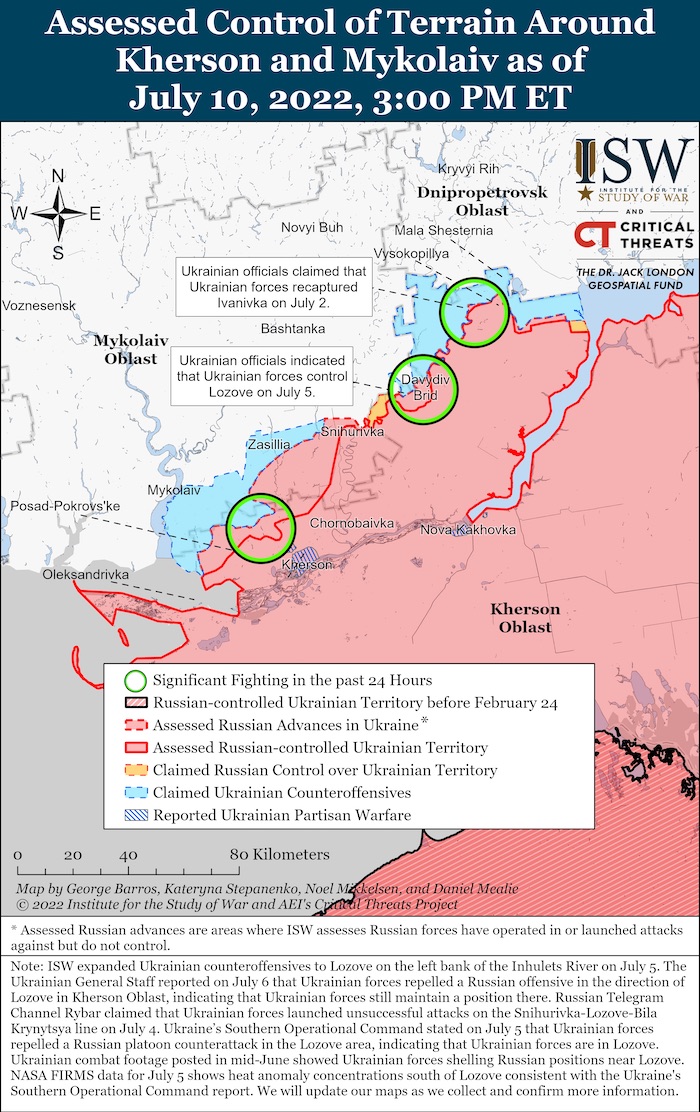
Reznikov also said that Ukraine has “passed the test” with its successful use of recently delivered American long-range artillery systems, but stressed the high attrition rate along its extensive front line has made the demand for additional supplies, such as armored vehicles and drones, more urgent, writes Wall Street Journal. He said that “the need for longer-range weapons continues to outpace the Ukrainians’ demand for shorter-range systems as the war shifts primarily to an artillery battle, and more will be needed if they are to recapture territory lost since Russia invaded on Feb. 24.”
I’m done believing we’re the stupid ones, Ukrainian soldier tells Jonathan Franzen
Russian forces sustain equipment and personnel losses in southern Ukraine. 38 Russian military personnel killed, 4 Russian howitzers destroyed, 5 military vehicles, two ammunition depots, and a portable surface-to-air missile system, reports the Kyiv Independent.
https://twitter.com/EuromaidanPress/status/1546234493853483008
No operational pause in Russian military operation, said Zelenskyy. “This week, many have been talking about an alleged “operational pause” in the actions of the occupiers in Donbas and other parts of Ukraine. 34 raids by Russian aviation over the past day is the answer to all those who came up with this “pause.”
Do we want a turning point in the war? 3 components... HIMARS for high-precision targeting rear bases, logistics. Heavy artillery on the frontline allows matching number parity. APC for "breakthrough fists"... More tools faster we'll clean our land of the Russians.
— Михайло Подоляк (@Podolyak_M) July 9, 2022
The Ukrainian army launched over 30 HIMARS strikes on the Russian military warehouses over the past weeks.
Russian helicopters and planes have not flown into the airspace over the territory controlled by the Armed Forces of Ukraine for more than 2.5 months. Russian aviation operates from outside the territory controlled by Ukraine.
Regional Updates
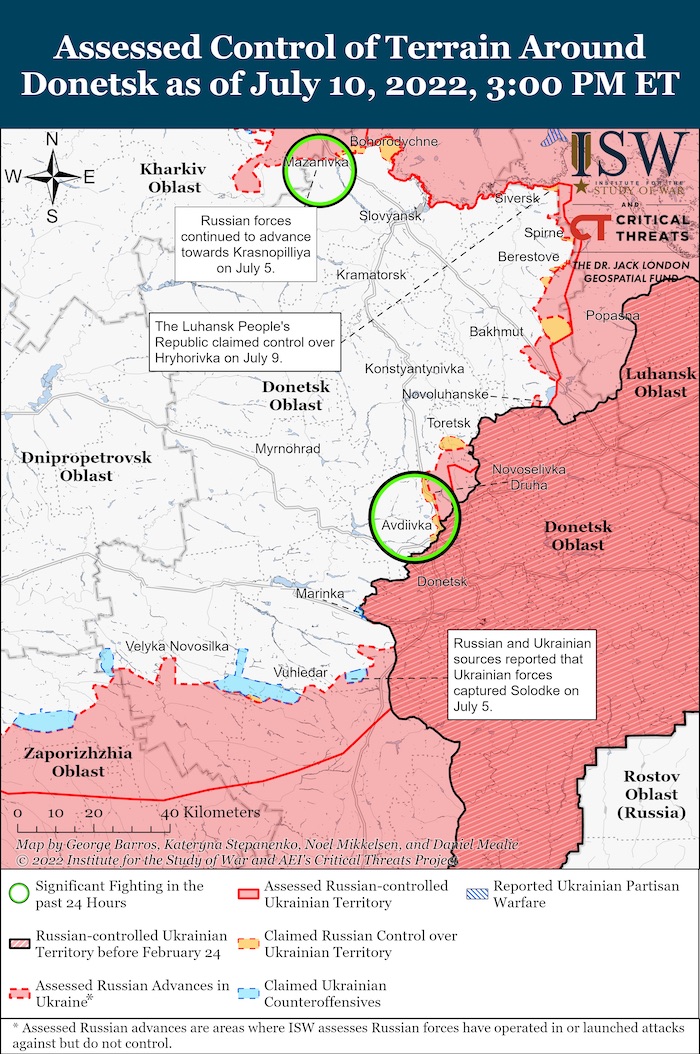
In the Donetsk Oblast, the Russian invaders destroyed a high-rise building in Chasiv Yar. 19 dead, 8 rescued from under the rubble.
Bookstore director Viktor Razzhyvin evacuated more than 25 thousand Ukrainian books from Sloviansk to Kyiv https://t.co/TvX4m5zRSP
He says he waits for liberation of Sloviank & won't open a bookstore in any other city. Books' fate could have been tragic: https://t.co/B8KOeS59qJ pic.twitter.com/PlLyQcttl8
— Euromaidan Press (@EuromaidanPress) July 11, 2022
Russian troops are withdrawing equipment from Mariupol towards the front line. A large convoy of vehicles marked V and 5 vehicles with the military headed towards occupied Berdiansk. The convoy also included a part of military equipment from storage facilities in Mariupol.
In the Luhansk Oblast, the Russians are still unable to occupy the entire Luhansk oblast. They use aircraft for attacks but did not advance and lost another ammunition depot. They launched five missile strikes and four massive artillery attacks on settlements. The Russians are using aircraft, cannon and rocket artillery, failing to break through from Lysychansk to Seversk and Sloviansk, trying to advance from Popasna. The supply of ammunition to their positions has been disrupted, but the losses have not yet reached a critical limit. The Russian army gathers troops near Bilohoryvka.
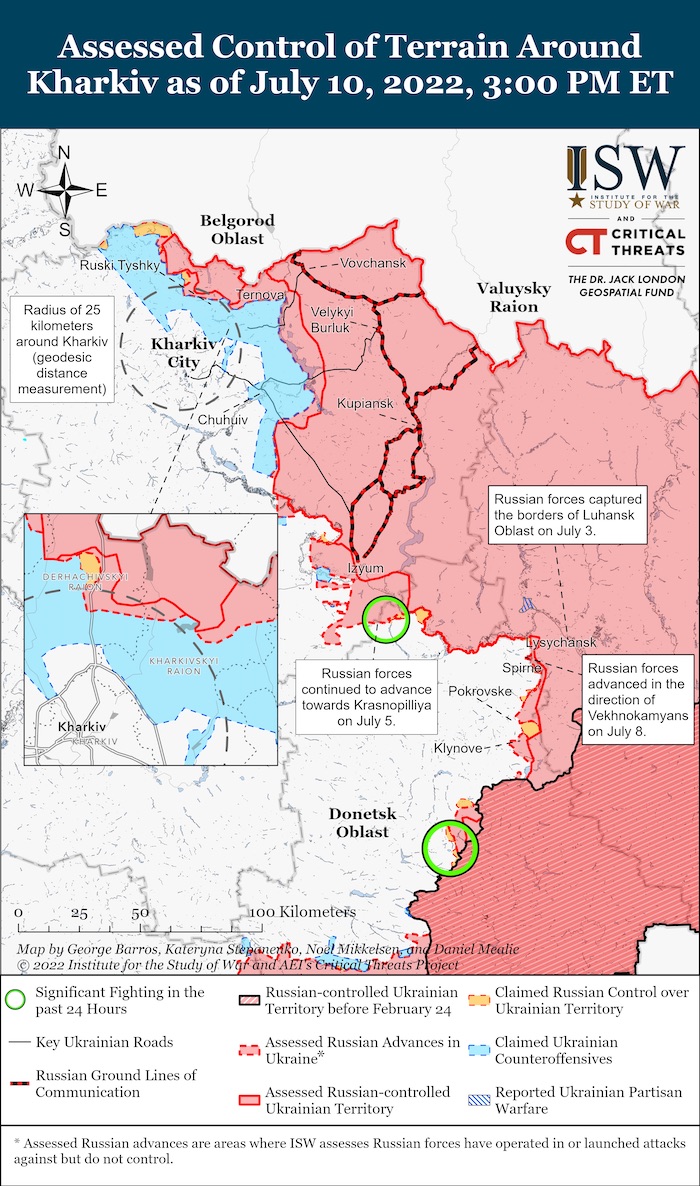
In the Kharkiv Oblast, the Russians are continuing the strikes on the city of Kharkiv. It was hit by rocket fire three times overnight. A residential building, a warehouse building, and a school building are damaged. No casualties or injuries.
https://twitter.com/EuromaidanPress/status/1546399630954487809
In the Dnipropetrovsk Oblast, a house, a barn and cattle were damaged. Several animals died and agricultural equipment damaged.
In the Kyiv Oblast, the NASAMS air defense system that protects the White House and the Capitol in Washington D.C. will be used to close the sky over Kyiv. The US will transfer the system to Ukraine. NASAMS can fire 72 rockets in 12 seconds and shoot down planes, helicopters, and cruise missiles.
In the Kherson Oblast, the Ukrainian army destroyed several ammunition depots of the Russian invaders, as well as in other parts of the occupied territories. The following Russian military objects were destroyed:
- command and observation post of the Russian artillery brigade,
- control and command post of the National Guard,
- 2 ammunition depots,
- 38 Russian servicemen,
- 4 howitzers “Msta-B”,
- portable anti-aircraft missile system,
- 5 vehicles.
Kherson Oblast residents to leave amidst Ukrainian plans for a southern counteroffensive. “Deputy Prime Minister Iryna Vereshchuk urged civilians in temporarily occupied Kherson Oblast to evacuate, as Ukraine’s Armed Forces are planning a counteroffensive in southern Ukraine. She did not indicate when the Ukrainian counteroffensives will occur,” writes the Kyiv Independent.
The Russians send a new batch of tanks and infantry fighting vehicles from Crimea in the direction of Kherson.
In the Black Sea, due to the storm, the Russians left only two large landing ships with 16 Kalibr-type missiles.
In Belarus, Russian military aviation flights intensified. All Russian Il-76 planes flew to the military airfield in Minsk’s vicinity. An increase in air training at 5 airfields at once is observed. Pilots from the Russian Federation arrived and landing training began.
According to British Defence Intelligence, (last 48 hours):
- As of Sunday 10 July, Russian artillery bombardments continued in the northern Donbas sector, but probably without any major territorial advances. Ukrainian forces continued to apply localised pressure to the Russian defensive line in North East Kherson oblast, also probably without achieving territorial gain.
- n late June, a Russian-language media agency based in Russia’s far eastern Lake Baikal region uploaded a video in which the wives of soldiers from the Eastern Military District’s (EMD’s) 36th Combined Arms Army directly appealed to a local politician for their husbands to be returned home from service in Ukraine. One woman claimed that personnel of EMD’s 5th Separate Guards Tank Brigade are ‘mentally and physically exhausted’, because they have been on active combat duty since the launch of the ‘special military operation’ on 24 February 2022. The lack of scheduled breaks from intense combat conditions is highly likely one of the most damaging of the many personnel issues the Russian MoD is struggling to rectify amongst the deployed force.
Losses of the Russian army
As of 11 July, the approximate losses of weapons and military equipment of the Russian Armed Forces from the beginning of the war to the present day:
⚰️russia's combat losses in Ukraine as of July 4
▪ 36200 killed soldiers (+230)
▪ 1589 tanks (+5)
▪ 3754 APV (+10)
▪ 804 artillery systems (+3)
▪ 217 aircraft and 187 helicopters
▪ 15 boats and cutters #StopRussia #StandwithUkraine pic.twitter.com/o44ScMxigM— VoxUkraine (@voxukraine) July 4, 2022
Humanitarian
347 children died as a result of the armed aggression of the Russian Federation in Ukraine. In total, more than 995 children suffered at the hands of the Russian occupiers — 347 were killed and more than 648 were injured.
16-year-old Vlad Buriak on Russian captivity: "It was my duty to clean the torture room. The biggest fear was hearing other people screaming when tortured"
Buriak spent 4 months in captivity. He is son of the chairman of Zaporizhzhia Oblast administrationpic.twitter.com/Gfi6Y3YltX
— Euromaidan Press (@EuromaidanPress) July 10, 2022
️️Environmental
Russian military forced Zaporizhzhia nuclear plant managers to allow blogger-propagandist to the block control panel of a power unit of NPP and to other premises with limited access
The safety rules are violated "for nice propagandist footage," Enerhotam https://t.co/B9aK1Teu4Z
— Euromaidan Press (@EuromaidanPress) July 10, 2022
At the Zaporizhzhia Nuclear Power Plant, armed Russians forced the NPP management to allow propagandists to shoot video interviews at the control panel to release a story about the allegedly safe operation of the station under Russian control.
Legal
The UN recorded 124 cases of sexual violence during full-scale Russia's invasion
UN rep Pramila Patten noted that available data are "only tip of the iceberg" and don't reflect scale of sexual violence in this war;cases difficult to detect and investigate https://t.co/eIEZ3jObQG
— Euromaidan Press (@EuromaidanPress) July 11, 2022
124 cases of sexual violence recorded during Russia’s war in Ukraine. UN Special Representative for Sexual Violence in Conflict said that this number is “just the tip of the iceberg” and does not reflect the scale of sexual violence in the context of the Russian war against Ukraine, since such cases are difficult to identify and investigate.
- Survivors of sexual abuse often hide it.
- It is impossible to assess the scale of crimes of this nature committed in Ukraine since there are too many of them.
- Some citizens do not have the physical ability to report the incident to law enforcement officers, because more than 20% of the territories of Ukraine are temporarily occupied.
Support
NATO’s new Strategic Concept gives short shrift to Eastern Neighborhood and Ukraine
France is preparing to cut down the Russian gas supply. France receives only 17% of its gas from Russia. Currently, a plan is being developed to completely phase out Russian gas. Cutting off supplies right now would be a problem, as many nuclear reactors are under maintenance. The first step is to reduce energy consumption by households and businesses, and then build new infrastructure.
Germany has blocked a package of EU assistance to Ukraine in the amount of 9 billion euros. The German authorities have been blocking the allocation of another tranche of EU aid to Ukraine for more than a month. Berlin approved only the first tranche of 1 billion euros.
New Developments
Germany tries to wrench a turbine out of Canada’s sanctions. It should press on Russia instead
Canada decided to return the Russian turbine for the Nord Stream 1 gas pipeline to Germany. The turbine was being serviced in Montreal. Gazprom called it the reason for the reduction in the volume of gas pumped to Europe.
Ukraine urged Canada not to succumb to the Kremlin’s blackmail and cancel the decision on the turbine. The Ministry of Energy and the Ministry of Foreign Affairs of Ukraine are “deeply disappointed with the decision of the Government of Canada to issue permission for the return to Germany of turbines repaired by Siemens Canada for Nord Stream 1,” both ministries said in a statement. “This dangerous precedent goes against the rule of law and will have only one consequence — reinforcing Moscow’s sense of impunity,” the statement said. The ministries also note that “the transfer of the Nord Stream 1 turbine will allow Russia to continue using energy as an instrument of a hybrid war against Europe.”
In March, number of countries that bought Russian grain halved comp. to Feb 2022. Yet, this did not affect the volume much. Main importers continue to receive supplies—Turkey, Egypt, Iraq, Saudi Arabia &"grey cargoes" (ships that don't specify destination) https://t.co/vxSmQfJiq2 pic.twitter.com/bI3P9fRKY9
— Euromaidan Press (@EuromaidanPress) July 10, 2022
Protests in Sri Lanka may be related to Russia’s blockade of Ukrainian grain, according to the US Secretary of State Anthony Blinken. He said that “the growing food insecurity is greatly exacerbated by Russian aggression against Ukraine” may have influenced the situation in Sri Lanka.He also mentioned the situation in Thailand, where fertilizer prices have risen significantly due to the blockade. Millions of tons of Ukrainian grain are annually exported to Africa, the Middle East, and other parts of the world. Currently, the exports have been halted as the Russian fleet blocks Ukrainian ports on the Black Sea.
Member of the US House of Representatives Victoria Spartz said that Zelenskyy “should solve the problem” of Andriy Yermak and called on the Ukrainian Foreign Ministry to take her statements seriously.
She listed several serious accusations against Yermak:
- information leaked to Belarus and eventually to Russia about the Ukrainian operation to seize the Wagner Group, which led to its failure;
- poor management of failed peace talks with Russia before the war;
- assuring the Ukrainian leadership that there will be no Russian attack in February, contrary to Western intelligence, to prevent Ukraine from properly preparing for war;
- sabotage of Kherson and providing it to the Russians for organizing the tragedy of the Azov battalion;
- delaying urgent purchases of military equipment through the Ministry of Defense of Ukraine and putting forward unreasonable or even illegal conditions;
- purposefully delaying the appointment of an independent anti-corruption prosecutor through his deputy.
- https://twitter.com/EuromaidanPress/status/1546237844343201799
Assessment
On the war.
The Institute for the Study of War has made the following assessment as of Saturday 11 July, 2022:
Russian forces are in the midst of a theater-wide operational pause in Ukraine. This operational pause has been largely characterized by Russian troops regrouping to rest, refit, and reconstitute; heavy artillery fire in critical areas to set conditions for future ground advances; and limited probing attacks to identify Ukrainian weakness and structure appropriate tactical responses. As ISW has previously noted, an operational pause does not mean a complete cessation of hostilities, rather that ongoing hostilities are more preparative in nature.[1]
Russian milblogger Rybar provided more evidence of tensions between the Russian military command and Russian war correspondents.[2] Russian war correspondents include journalists operating at the frontlines and Russian milbloggers commentating on information available in the open-source (and likely also drawn from friends in the military). Rybar noted that Russian military commanders responsible for wartime information operations are attempting to silence Russian milbloggers and war correspondents to conceal the Russian military’s blunders during the invasion of Ukraine. Rybar noted that Russian military commanders remain shaped by negative experiences during the Chechnya wars when war correspondents exposed problems at the frontline to the Kremlin and embarrassed Russian officers.
Rybar stated that the Russian Defense Ministry and possibly actors within the presidential administration are actively attempting to silence unofficial coverage of the Russian war in Ukraine. Rybar expressed support for a Telegram article by Donetsk People’s Republic (DNR) Deputy Information Minister (and milblogger) Daniil Bezsonov that criticized the Kremlin’s apparent effort to promote self-censorship among war correspondents.[3] Rybar noted that Adviser to the Russian Defense Minister Andrey Ilnitsky called for such self-censorship on May 26 and had encouraged Russian war correspondents to report on the war only from an ideological standpoint without getting into operational details.[4] Rybar speculated that the presidential administration or other Russian officials ordered Ilnitsky to promote censorship among war correspondents who publish frontline updates in real-time.[5]
Rybar noted that the relationship between the Russian military command and war correspondents particularly soured after Russian President Vladimir Putin met with war correspondents during the St. Petersburg Economic Forum on June 17. Rybar claimed that two prominent war correspondents told Putin about the “mess” at the frontlines during the closed-door meeting, effectively bypassing the Russian Defense Ministry in presenting their negative views directly to the commander in chief. The event Rybar is describing likely occurred: Kremlin Spokesperson Dmitry Peskov announced on June 12 that Putin would hold a largely closed-door meeting with Russian war correspondents, and Russian propagandist Margarita Simonyan confirmed that Putin had a “candid” and long conversation with frontline journalists after the event.[6] Rybar noted that Russian Defense Ministry began to identify war correspondents as a “threat” after this engagement whereas previously it had perceived them as a “poorly controlled problem.”
Putin likely held the June 17 meeting to defuse milblogger discontent, which had become evident and dramatic after the disastrous failed river crossing attempt at Bilohorivka in mid-May. If that was his aim, he failed to win them over, as the milbloggers have remained staunchly critical of the way the Russian high command is waging the war ever since. But Putin may also have obtained a more unvarnished view of what is occurring on the frontlines than he was getting from the chain of command.
The Russian information space would change significantly if the Ministry of Defense cracked down on the milbloggers and stopped them from operational reporting. ISW uses milbloggers and Russian war correspondents as sources of Russian claims on a daily basis, so the elimination of regular milblogger operational reporting would affect ISW’s approach to coverage. We will continue to observe and report on milblogger and war correspondent behavior and will flag significant changes in the Russian information space as we observe them.
Russian milbloggers are increasingly criticizing Russian strategy and military leadership by seizing upon recent successful Ukrainian strikes against Russian rear areas.[7] Russian milblogger Voennyi Osvedomitel’ underlined the threat posed by Western-provided high mobility artillery rocket system (HIMARS) and stated that HIMARS will complicate Russian logistics in a Telegram post on July 9.[8] Voennyi Osvedomitel’ cautioned that Russian air defense may be increasingly insufficient against Ukrainian strikes and called on Russian forces to improve coordination between intelligence and aviation in order to identify and target Western-provided weapons systems. Another milblogger with a small following, Nam Pishut iz Yaniny, complained that Russian military leadership is proving unable to defend against Western weapons being used against Russian positions.[9] Igor Girkin, a Russian nationalist who previously commanded militants during operations in Donbas in 2014, discussed recent Ukrainian strikes against Russian rear areas and criticized Russian troops for not targeting Ukrainian ground lines of communication (GLOCs) along which HIMARS and other Western weapons are delivered.[10] Girkin suggested that the ongoing operational pause is exposing easily-exploitable Russian vulnerabilities and called for Russian troops to start fighting in full force again. Girkin and other milbloggers are likely to continue voicing their discontent with Russian military leadership as Ukrainian capabilities are strengthened by Western weaponry and equipment.
Key Takeaways
- Russian forces are conducting a theater-wide operational pause in Ukraine and engaging in operations to set conditions for future offensives.
- Russian forces conducted limited probing operations northwest of Sloviansk.
- Russian forces are likely intensifying artillery and missile strikes west of Bakhmut in order to isolate the city from critical ground lines of communication (GLOCs).
- Russian forces conducted a limited and unsuccessful ground attack north of Donetsk City.
- Russian military leadership continues to form ad hoc volunteer units and private military company combat organizations partly comprised of older men and criminals to support operations in Ukraine.

